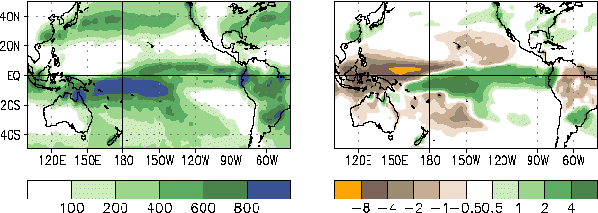
> English > Climate Encyclopaedia > Weather > more > 2. Major wind systems > * Worksheet 1
|
|
 |
Weather
More |
2. Major wind systems - more
El Nino / La Nina
Worksheet 1: Southern Oscillation |
|
In the 'Basics' section you have seen the normal condition in the pacific and also the deviations under El Niņo conditions. (under the heading of 'El Niņo' and in the worksheets in the 'Basics' section). In the 'More' section - under the heading of 'El Niņo and SOI' you get more information. After having gone through the material in these two sections, you should be able to answer the following questions.
The seasonal variation of the pressure patterns is called the Southern Oscillation.
Whenever this happens - every 3-6 years - the whole system in the pacific plays up.
|
|
|
|
|
Think of the texts and animations/maps before.
Can you answer the following questions?
|
|
| 1) Under El Niņo conditions the sea level is ... |
|
|
| 2) Under El Niņo conditions the trade winds ... |
|
|
| 3) Under El Niņo conditions the trade winds ... |
|
|
| 4) Under El Niņo conditions the trade winds ... |
|
|
| 5) Under El Niņo conditions ... |
|
|
| |
|
|
|
Attention: This quiz is optimised for internet explorer or new versions of Netscape!
If the little solution window disappears, just reopen it from the task row! |
|
|
|
|
|
|
| |
|
And how does El Niño affect the whole Pacific region?
Look at the maps showing the precitpiation and the deviation from the normal year.
Name the regions/countries which have more rain than usual and those which have less.
Drought conditions often result in bush fires, poor harvests, and economic problems.
Precipitation total deviation from
January-March 1998 (mm) normal (factor 100) |
 |
 |
|
Drought in South East Asia under El Niño conditions. author: Bildungszentrum Markdorf'Projektgruppe ENSO', data from NOAA climate prediction center, source: http://www.enso.info/enso.html#normal
|
|
The whole phenomenon is called ENSO which is short for "El Niño" and "Southern Oscillation".
In short
ENSO conditions are irregular weather conditions which occur frequently and mean world wide weather disturbances:
Either drought and no rain (where there should have been rain)
or too much rain (where no rain is expected).
|
About this page:
- Author: Dr. Schrettenbrunner - University of Nürnberg - Germany
- scientific reviewing:
- educational reviewing: Dr. Yvonne Schleicher , Julia Heres
- last update: 08.09.03
|
 > English > Climate Encyclopaedia > Weather > more > 2. Major wind systems > * Worksheet 1
> English > Climate Encyclopaedia > Weather > more > 2. Major wind systems > * Worksheet 1
